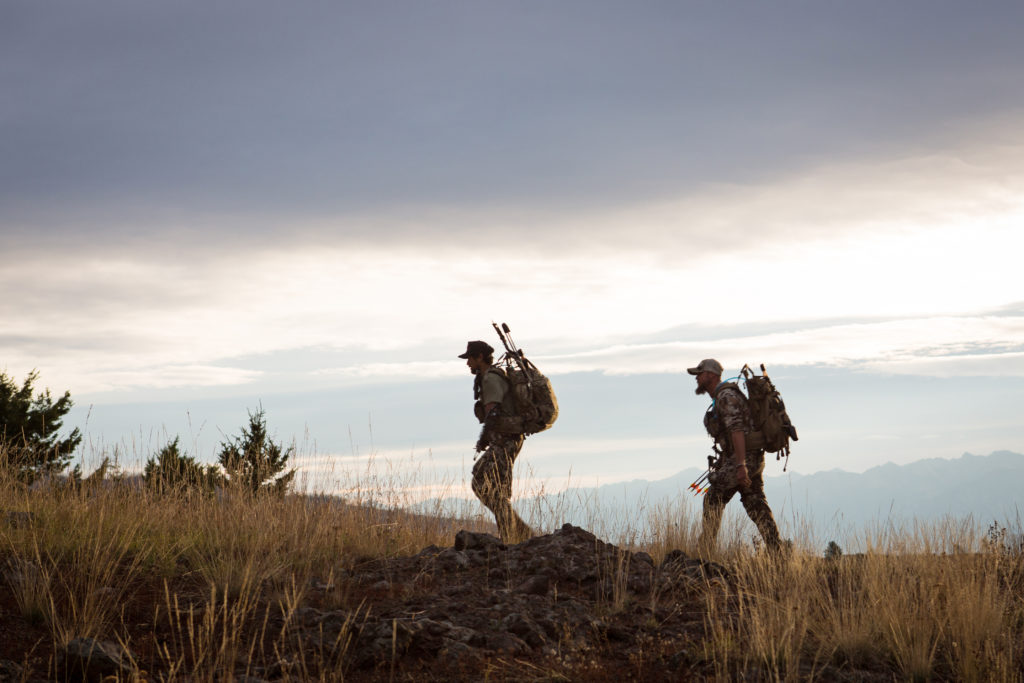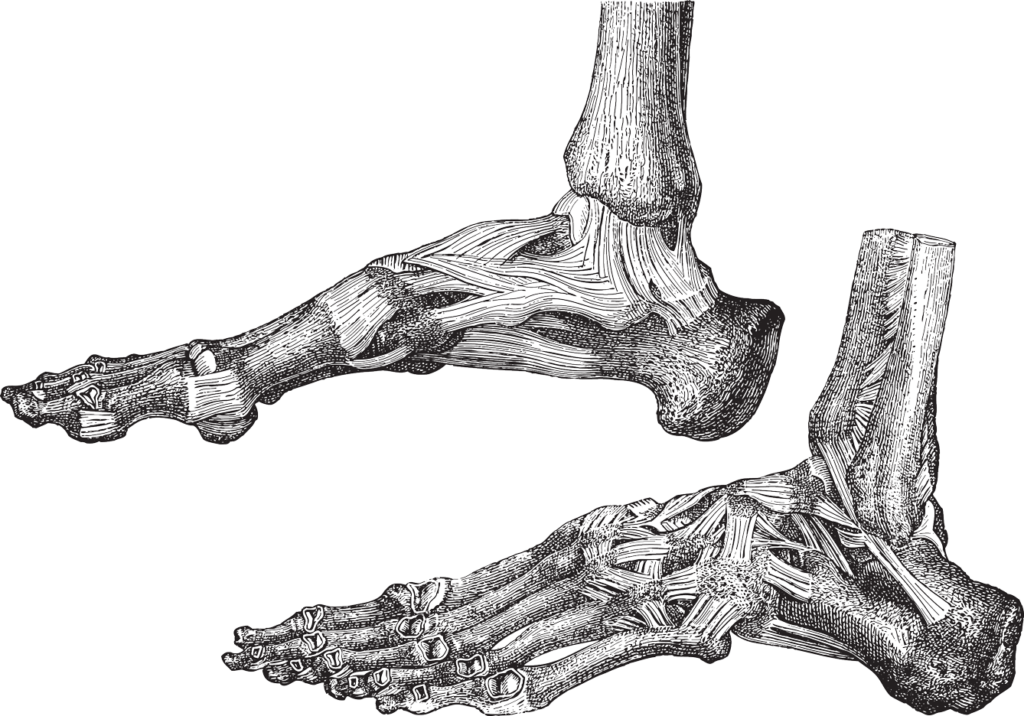Feature Image Photo Credit Steven Drake
As a mountain or western hunter, what would you say is the most important tool for the job? Think hard on this one, it’s not entirely obvious.
Your gun? Bow? Pack? Perhaps your optics? All perfectly justifiable, but dead wrong across the board. The correct answer would undeniably be your feet. There simply is no topic or piece of “equipment” more critical to your hunting success. The ability to reliably cover ground is unquestionably the definitive “skill” of the mountain hunter.
In this new column, Roam, we will be going deep on the topics of footwear, foot care and the keys to a long life of mountain mobility with the experts at Schnee’s in Bozeman, MT.
Hiking, climbing, stalking and packing out game would not be possible without a well-functioning lower-limb system (feet, ankles, lower legs, boots and socks). If you can’t travel to the animals (think high, far, and ugly), your weapon and fancy gear are merely expensive accessories helping you look the part in your truck, at camp or on your horse looking up at a mountain. This “system” as I’m referring to it is also one of the most complex in the human body and far too often the limiting factor in many hunter’s pursuits. This unforgiving fact is why your lower-limb system deserves its own dedicated column in the JOMH.
If you’ve ever had problems with your feet, ankles, or lower legs you know just how debilitating an injury, poorly fitting boot, or blister can be. Outside of acute trauma like a fracture or severe ankle sprain, the overwhelming majority of foot and ankle problems are cumulative (build up over time) and preventable. Many, if not most, lower-limb related issues can be addressed through appropriate self-education and a commitment to adequate preparation.
For much of this column we’ll be drawing on the deep experience from the legendary bootmakers at Schnee’s. Between their decades of experience both making and fitting boots and my nearly fifteen years in the field of clinical biomechanics we are going to take a deep dive into the integral subjects of boot-fitting, boot-making, injury prevention and backcountry foot care. We’ll be jointly delivering the knowledge, preparation and inspiration to ensure your entire lower-limb system is tough enough for any terrain.
If you’re truly committed and motivated to prepare your feet, ankles and lower limbs to handle the demands of countless miles in the roughest terrain on the planet this is the column you’ve been waiting for. Let’s dive in.
The human foot is one of the most unique structures in Nature. Each foot has 26 bones, 33 joints and over 100 hundred ligaments, tendons, and muscles. To put that in perspective, your two feet house 25% of all the bones in your body. They are integral to absorbing the impact of walking, hiking, running and jumping and essential to the stability in your ankles, knees and hips. They allow you to transfer power from the rest of your body into the ground, and propel yourself across the landscape or up and over mountains.
Many evolutionary biologists believe the unique composition of our feet and lower-limbs was critical to our evolution into the preeminent meat-eater on the planet. Our ancestor’s first forays into hunting were what are known as “persistence hunts” where they literally ran prey to exhaustion. This was made possible in large part due to the inherent “springiness” or elasticity of the feet and lower legs, making them incredibly efficient at covering ground. Far more efficient than virtually any other predator on Earth. Our feet are an inextricable part of our hunting ancestry and have been since the dawn of time.
The reality of modern life, however, is our world is a far cry from that of our ground-covering ancestors. The overwhelming majority of modern-day weight-bearing time is spent on hard, flat surfaces.
All those bones, joints, muscles, tendons and ligaments are designed to serve a purpose, primarily to act as a mobile, adaptive and elastic suspension system. The problem with constant exposure to flat surfaces is we end up overusing certain muscle groups and underutilizing other muscle groups. This is like going to the gym every day and doing the exact same exercise…for thousands and thousands of repetitions. And given the average North American takes 10,000 steps per day this is no small amount of volume. The constant overuse of the same muscles day in and day out leads to range-of-motion problems in the joints themselves and then these joint restrictions feed back into the muscle imbalances and the cycle just keeps repeating itself.
The bottom line is most people have lost the inherent mobility and elasticity their feet and lower limbs are meant to have and this is a fundamental requirement of optimal lower-limb function. Improving upon this fundamental ability will not only make you a stronger, more durable mountain hunter but will help with stability in your knees, hips and back as well. It will also ensure you end up choosing the best boot for your individual foot shape/type and most importantly foot function.
If you’re in the market for new boots this year, selecting a boot prior to working on the base functionality of the foot, ankle and lower legs is like putting new tires on a truck that needs its suspension and chassis overhauled. Properly built and fit boots will go a long way to keeping you mobile and functional in the backcountry but why not optimize what’s going on inside your boots as well?
So, before we dive into the integral subjects of boot (or other footwear) selection and boot-fitting, in this initial article we will focus on the feet, ankles and lower-limbs themselves. There are some very basic but highly effective techniques you can employ on a day-to-day basis that will significantly improve your foot and lower-limb mobility and stability and prepare you for the relentless demands of the backcountry. The key is to start now and be consistent with these techniques. It takes time to peel back years of muscle imbalances and compensations and due to the volume of steps the average person takes per day (remember 10,000 + for the average North American) consistency is paramount. To use the gym analogy again, if you work out once per week but sit on your ass and eat like crap the rest of the week, that time in the gym won’t amount to much. The good news is with as little as 10 minutes per day you can make significant progress.
It should be noted that the order of techniques listed below is integral. Doing any one of these on an isolated basis will be beneficial BUT following the protocol as it’s outlined will produce the best and fastest results, bar none.
It should also be noted that if you are recovering from a recent foot or ankle injury OR are have undergone foot and/or ankle surgery in your past you should not employ these techniques without talking to your physician.
With that aside, let’s move on to the techniques. The protocol below should take you no more than 10 minutes to complete from start to finish. If done daily, you should see significant improvements in mobility, balance, and overall stability within 4 – 6 weeks. That does NOT mean you can stop doing them 4 – 6 weeks after starting them. In an ideal world, these become a regular part of your day-to-day life. Remember, unless you remove the constant exposure to hard, flat surfaces from your daily life the need for these techniques remains high on your priority list. That said, if you can commit to a solid 4 – 6 weeks of consistent daily work on these techniques, most people find they can maintain their improvements on a 3 days/week schedule from that point forward.
- Foot release drill (~2 mins):
- As noted earlier in the article, the feet are meant to be elastic and adaptive structures that allow the body to handle virtually any terrain it might encounter. Over a lifetime of walking and standing on predominantly flat, linear surfaces that elasticity (or more appropriately mobility) is often lost. A very simple (but not overly pleasant) home-therapy technique is to use a lacrosse ball, baseball or softball to mobilize the tissues and structures of the soles of the feet. The video HERE provides a great breakdown of how to tackle this. Watch from 0:40 – 3:50 but it should only take you 2 minutes to do this on your own.
- Lower-leg self-massage (~2 mins):
- Every muscle in the lower-leg has a direct impact on foot and ankle function and performance. The average North American’s calf, shin and ankle stabilizing muscles are often imbalanced meaning certain muscles are overused on a day-to-day basis while others are underutilized. This eventually leads to chronic issues with both mobility and stability in the ankles and feet but can be addressed with another relatively simple home-therapy technique. There are a variety of products designed for this purpose (usually found at larger sporting goods stores) but you can also simply use a rolling-pin. If using a rolling pin be careful with the amount of pressure applied. This should be uncomfortable but not painful. The video HERE provides a good breakdown of the technique from 2:15 – 4:20.
- Ankle Box Drills (~5 mins):
- Points 1 and 2 above are essential to achieving results but these “box” drills are without question the most critical component of this protocol. It is essential that these be done after the other techniques. The key with this drill is to focus on maximum They should feel like work and you are likely to experience mild discomfort or even a similar “burn” to what you might feel in the gym when a muscle fatigues. Unfortunately, the bulk of the videos available online are overly simplistic or dead wrong in their application so I have written out the directions here. This is a simple approach that when combined with the home therapies above will produce significant improvements in mobility and stability. These should be completed in a seated position so the ankles and feet are suspended in the air, ideally off the end of a couch, ottoman or foot stool. You are basically going to draw a box (in the air) with your feet. Start by pulling your foot back towards the shin, with the big toe and kneecap in line with each other. Keeping the foot pulled up towards the shin, turn the foot inwards. This is the first corner of the box. From there point the foot/big toe down in as straight a line as possible. Now keeping the foot/toe pointed, turn the foot outwards. Keeping the foot turned outwards, pull the foot/toe back up towards the shins. Then turn the foot back inwards, returning to the first corner of the box. Then do the full circuit in reverse. Repeat for 3 – 5 minutes or until you experience cramping. You can either do this drill one foot at a time or both feet simultaneously.
In Summary
With a relatively small time commitment and some simple techniques we can improve mobility, stability and power in the feet and ankles. Doing this will increase your strength, endurance, and durability and improve your ability to cover ground, climb mountains and come back down heavy.
In next month’s column, we’ll start systematically dissecting boots and how the construction, components and craftsmanship of a mountain boot impact your lower-limb system and your ability to go deeper, further and higher than you ever thought possible.





